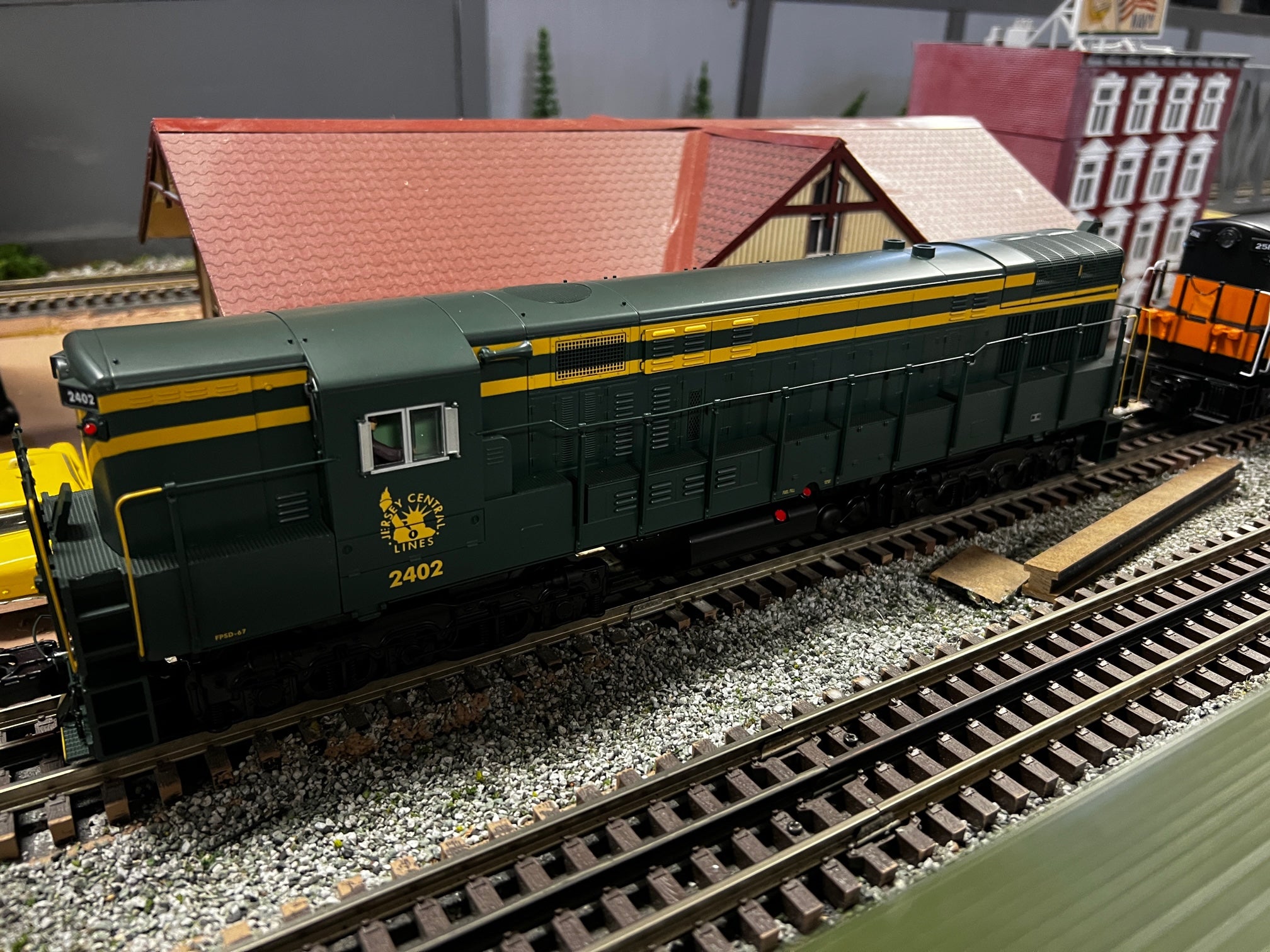Resources
About & Contact Us




MTH 20-21647-1 - FM Train Master Diesel Engine "Jersey Central" #2406 w/ PS3 (Hi-Rail Wheels)
- Sale price
- $ 419.95
- Regular price
- $ 559.95
- You save
- $ 140.00 (26%)
Product Information
| Announced Date: | April 2022 |
| Released Date: | Jan 2023 |
| Individually Boxed: | Yes |
- Road Name: Jersey Central
- Road Number: 2406
- Product Line: Premier
- Scale: O Scale
Features:
- Intricately Detailed, Durable ABS Body
- Die-Cast Truck Sides, Pilots and Fuel Tank
- Metal Chassis
- Metal Handrails and Horn
- Metal Body Side Grilles
- (2) Handpainted Engineer Cab Figures
- Authentic Paint Scheme
- Metal Wheels, Axles and Gears
- (2) Remote-Controlled Proto-Couplers
- O Scale Kadee-Compatible Coupler Mounting Pads
- Prototypical Rule 17 Lighting
- Directionally Controlled Constant Voltage LED Headlights
- Lighted LED Cab Interior Light
- Illuminated LED Number Boards
- Lighted LED Marker Lights
- (2) Precision Flywheel-Equipped Motors
- Operating ProtoSmoke Diesel Exhaust
- Onboard DCC/DCS Decoder
- Locomotive Speed Control In Scale MPH Increments
- Proto-Scale 3-2 3-Rail/2-Rail Conversion Capable
- 1:48 Scale Proportions
- Proto-Sound 3.0 With The Digital Command System Featuring Freight Yard Proto-Effects
- Unit Measures: 17” x 2 5/8” x 3 7/8”
- Operates On O-42 Curves
- Headlight/Taillight
- Bell
- Horn
- Start-up/Shut-down
- Passenger Station/Freight Yard Announcements
- Lights (except head/tail)
- Master Volume
- Front Coupler
- Rear Coupler
- Forward Signal
- Reverse Signal
- Grade Crossing
- Idle Sequence 3
- Idle Sequence 2
- Idle Sequence 1
- Extended Start-up
- Extended Shut-down
- Rev Up
- Rev Down
- One Shot Doppler
- Coupler Slack
- Coupler Close
- Single Horn Blast
- Engine Sounds
- Brake Sounds
- Cab Chatter
- Feature Reset
- Smoke On/Off
- Smoke Volume
Overview:
Fairbanks Morse got into the locomotive business because it made submarine engines. FM's unique opposed-piston diesel engine powered about half the U.S. Navy's World War II submarine fleet and developed a great reputation for reliability; the adaptation to railroad equipment during and after the war seemed like a natural transition.
In the opposed-piston motor, each cylinder had a piston at either end and the combustion chamber in the middle. There were no valves or cylinder heads. Intake and exhaust occurred through holes in the cylinder walls. The upper and lower banks of pistons each powered a separate crankshaft, and the two crankshafts were linked together to power the locomotive. While this sounds like a complex way to build an engine, the O.P. diesel in fact had several advantages over a conventional motor: less moving parts, terrific acceleration, and about double the horsepower per cylinder.
In 1953 the O.P. engine reached its zenith in the Trainmaster. Introduced at the Railroad Manufacturers' Supply Association show that year, FM's new locomotive took the show by storm. It was the most powerful single-motored diesel locomotive of its era and had a brawny body to match its bold name. Emblazoned in bright yellow and red, four Trainmaster demonstrators barnstormed the country and walked away with any consist the railroads threw at them. For one brief moment, Fairbanks Morse looked like a contender.
Ultimately, however, the opposed-piston engine proved ill-suited to locomotive use. The bone-jarring railroad environment was much rougher on the motor than a submarine cushioned by an ocean. The top crankshaft proved prone to oil leakage. Perhaps most important, maintenance was a nightmare. Whereas a single bad cylinder in an Electro-Motive diesel could be accessed by pulling off one cylinder head, a cylinder repair in an O.P. engine required removal of the top crankshaft and removal or disconnection of the entire top bank of cylinders - which also meant the roof of the locomotive had to come off. Ultimately, only 127 Trainmasters were sold to 11 U.S. and Canadian railroads.
In the world of O gauge railroading, however, the Trainmaster was a hit from the moment it went on the market in the mid-1950's. The engine's massive size and tremendous pulling power have made it one of the most-loved engines among 3-rail operators for nearly half a century. The Premier Trainmaster comes complete with the digital sound, amazing slow speed capability, and variable smoke output that make Proto-Sound 3.0 the best sound and control system in model railroading. Unlike past iterations of the Trainmaster from other model railroad companies, our model's tooling was designed to allow us to customize the model according to each railroad's prototype. In short, this is the most accurate Trainmaster ever constructed for the O Gauge marketplace.
We Accept
Recommended for You
Browsing history
- Choosing a selection results in a full page refresh.
Get in touch
177 W Main St
Atlanta, IN 46031
765-292-2022
support@mrmuffinstrains.com
Keep in Touch
Sign up for our newsletter and be the first to know about coupons and special promotions.
Country/region
© 2025, MrMuffin'sTrains Powered by Shopify
